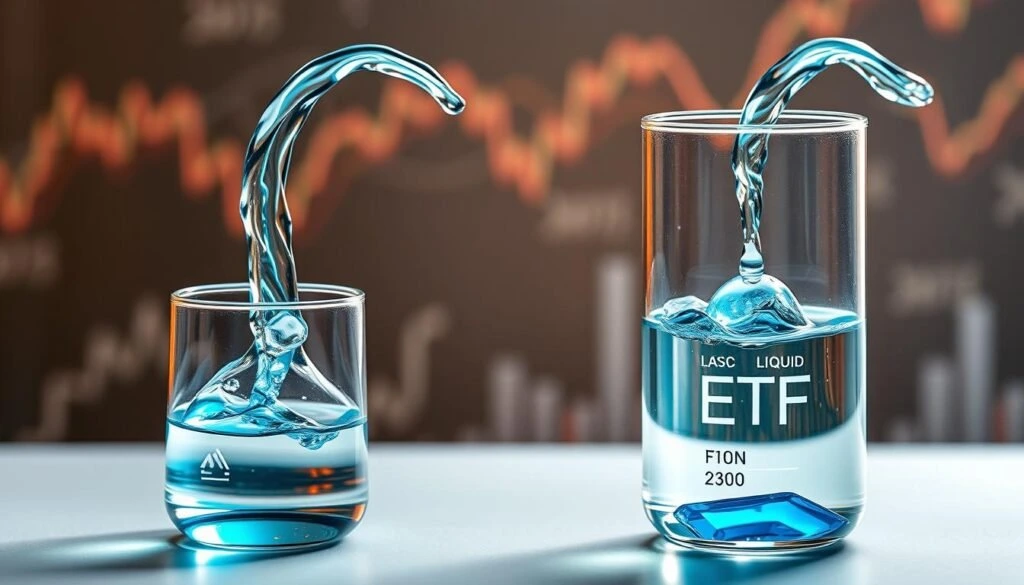Did you know over 90% of the $500 billion in India’s liquid funds are in securities that mature in 91 days? This shows how liquid and focused on the short-term these funds are. But, there’s another option for keeping your money safe and liquid. Liquid exchange-traded funds (ETFs) have their own special features and benefits.
We’ll look closely at liquid funds and ETFs. We’ll explore what makes them unique, how they perform, and who they’re best for. Knowing the differences can help you choose the right option for your short-term investments.
Table of Contents
Understanding Liquid Funds and Liquid ETFs
For those looking for safe investments, liquid funds and ETFs are great choices. Liquid funds invest in short-term, liquid money market instruments. They aim to keep your money safe and liquid, perfect for short-term goals.
What are Liquid Funds?
Liquid funds invest in high-quality, short-term debt like treasury bills and commercial papers. They offer growth and income plans, letting you pick how you want your returns. These funds are known for quick redemptions and no exit loads, making them flexible.
What are Liquid ETFs?
Liquid ETFs are traded on stock exchanges and invest in overnight securities. They are a liquid cash option, requiring a demat account for trading. Liquid ETFs have lower costs and distribute returns as dividends.
Both liquid funds and ETFs are low-risk, stable investments for short-term needs. Liquid funds offer easy redemption, while ETFs are transparent on stock exchanges. Choose what fits your investment goals and preferences.
Performance and Cost Analysis
Choosing between liquid funds and liquid ETFs needs a close look at their performance and costs. Liquid ETFs usually have lower returns than liquid funds because they focus on overnight securities. Transaction costs and taxes also cut into their returns. Plus, their expense ratios are often higher than those of liquid funds.
For instance, the Nippon India ETF NIFTY 1D Rate Liquid BeEs has an expense ratio of 0.69%. Liquid funds, on the other hand, have ratios ranging from 0.07% to 0.31%.
But, liquid ETFs have perks for traders and direct equity investors. They let investors earn on cash not being used and use ETFs as trading margin. For those looking for long-term gains, liquid funds might be cheaper due to their lower expense ratios.
“Liquid Funds with larger Assets Under Management (AuM) tend to have higher returns, ranging from 6.92% to 7.53%.”
How well liquid funds perform also depends on Crisil Ratings, which range from 1 to 5. These ratings affect investor choices and risk views. Funds from big names like HDFC, ICICI Prudential, and Aditya Birla Sun Life have shown strong performance. They offer stable and reliable options for investors.
On the other hand, liquid ETFs mainly invest in overnight securities like Tri-Party Repo (TREP) and the CBLO rate. They track indices like the BSE Liquid Rate Index and the Nifty 1D Rate Index. Even with lower returns, they offer quick transactions and cost savings. This makes them appealing for those who value fast and efficient portfolio management.
Conclusion
Choosing between liquid funds and liquid ETFs depends on what you need and want. Liquid funds are great for those without a demat account. They offer higher returns and lower costs, and you can buy a part of a fund.
Liquid ETFs are better for those who like to trade stocks. They let you earn on cash you’re not using and can be used for trading. This makes them good for active traders.
When picking between these options, think about what you need. Look at liquidity, costs, returns, and how they fit into your investment strategy and portfolio diversification. Making a choice that matches your financial goals and risk level is key.
Both liquid funds and ETFs let you earn on cash while keeping it liquid. Knowing what each offers helps you use them wisely. This way, you can improve your short-term investment plan.


